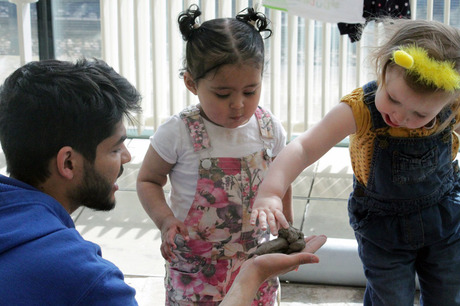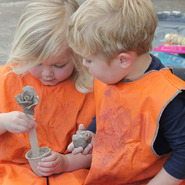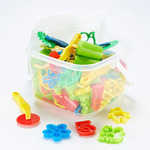
Clay might not have the instant wow factor of other art materials. It’s not brightly coloured and it doesn’t have the range of textures possible with paint and fabric, but young children love to explore it, manipulate it, get messy with it and make transient creations and 3D constructions.
Ammie Flexen, ceramic and early years artist, says, ‘It can appear to be a pile of mud, but there might be a myriad of ideas and thoughts that are being processed and imagined while the children explore the clay.
‘It has so many endless possibilities and can be a really helpful indicator of children’s level of develop­ment in manipulative skills, confidence, vocabulary, concentration and imagination.’
Clay is a cost-effective, valuable learning material, especially if it’s at hand for children to access on a regular basis.
WORKING WITH CLAY

Children at Eureka Nursery in Halifax benefited from a week of sessions with Ms Flexen, developing ways of working with clay. She explains, ‘As an artist working in early years, I work with a wide range of processes and materials, but wherever possible I will always begin by introducing clay.
‘I tend to offer it on a big scale – we had three builder’s trays full of clay in my first session at Eureka – with a range of open-ended resources, anything from builder’s blocks to plastic tubes and small-world objects. By placing other resources with the clay, children who are new to the experience will be able to access the clay through familiar and enticing objects. I tend to use clay as an open-ended process that enables children to access the clay at their own level of ability and confidence.
‘In the under-twos group, one child wasn’t confident in touching the clay, but was very interested in the drainpipes I brought with me. So, I rolled a ball of clay and sent it down the pipe to appear by magic at the other end. This fascinated him and became the game for a while – the game was the means to get him to touch the clay and before long he was manipulating the clay himself.’
 The calming effects of working with clay were also in evidence in the sessions, according to Ms Flexen. ‘Because of its nature, children can change it, manipulate it in a range of ways and it’s possible to create endless ideas that suit the transient ways that children develop, alter and revisit their ideas. During one session, we experienced children under two years old concentrating and engaging with the clay for an hour while one child, from the older group, continued to draw her flower sculpture after the session ended.’
The calming effects of working with clay were also in evidence in the sessions, according to Ms Flexen. ‘Because of its nature, children can change it, manipulate it in a range of ways and it’s possible to create endless ideas that suit the transient ways that children develop, alter and revisit their ideas. During one session, we experienced children under two years old concentrating and engaging with the clay for an hour while one child, from the older group, continued to draw her flower sculpture after the session ended.’
For the final session, children were introduced to the potter’s wheel. Because this is a real tool, children had to follow procedures and learn about safety. Ms Flexen explains, ‘The steps to making a pot are in a sequence that the children picked up very naturally and quickly just by being so engaged and involved in the process.
‘I had just cleaned the wheel when one of the children brought a lump of clay and carefully placed it on the wheel, in the centre. Having seen me do this, she was making it clear she was ready for us to make another pot.’
Finally, having worked with staff to build skills and confidence in using clay with the children, parents, carers, grandparents and children from babies to early teens joined in to create characters, castles, trees and endless experiments with clay and other materials such as pipe cleaners, straws and sequins for the Maker’s Faire at Eureka Museum.
CONTINUOUS PROVISION
When offering clay on a smaller scale as part of their continuous provision, practitioners can offer visual stimuli or link it to any relevant topic.
Add resources such as still-life objects, photos and images to inspire the children, and try adding different objects and materials such as sequins and pipe cleaners. Clay can also be painted with ordinary paints once it’s dry, but it does become more fragile to handle unless it is fired.
Here are some tips from Ms Flexen on the best ways to use clay:
Roll coils or snakes to create patterns, shapes, make letters or build taller coiled structures.
Roll flat, like pastry, and press in textures and stamps. Roll the clay on calico or hessian or it will stick.
Squeezing, stretching, pulling, sticking, pinching movements will all help with fine motor skills.
Add pipe cleaners, straws and other art materials.
Use the clay to add a new dimension to small-world environments, creating roads, bridges and trees.
Most pre-schools don’t have access to kilns and it’s not necessary. Young children find it difficult to connect a ‘fired’ piece, due to the timescale and the fact that it looks so different. Look after the clay, re-use it and treat it as an ongoing process. If it does dry, it can be painted or displayed, but if kept damp with a damp cloth it can be reused and enable children to re-visit their ideas as they develop.
Keep clay in a strong, air-tight plastic bag and squeeze all the air out. If the clay is soft enough to use, tie up the bag or, if you need it softened, sprinkle in some water and leave it to soak overnight.
If the clay is getting a little bit too hard to work with, use a stick to poke holes all over it (this will allow the water to penetrate the clay over a few days); add a couple of cups of water; tie up the bag and leave it; then knead the clay through like dough when you want to use it again.
ESSENTIAL RESOURCES
Most school suppliers sell clay. It is often called ‘school buff’, ‘school earthenware’ or ‘school stoneware’. Any of these are fine for children to use. Ms Flexen advises practitioners to avoid using ‘red’ or ‘terracotta’ with very young children as it has a high iron content and stains. Clay can also be bought directly from clay suppliers, such as Potclays and Potterycrafts, but there is a carriage charge.
Trying other clays such as red clay gives children a different material experience, but aprons or old clothes are essential to avoid staining the children’s clothes.
Products include:
Air Drying Clay Stone, 12.5kg, £7.45; White Earthenware Clay, 10kg, £6.55; Rolling Pin, £2.95; Metal Modelling and Carving Tools, £21.95 – all from www.ypo.co.uk
 Active World Tray, £15.99; Animal Pattern Rocker Stampers, £5.99; New Clay 12.5kg, £8.99; Air Dry Modelling Clay, £4.25; Das Air Hardening Clay, £5kg, £9.99; Clay Moulds & Tool Bucket, £39.95; Clay Modelling Tools, £3.99; Cutting Wire, £0.99; Potters Knife, £1.99 – all from www.tts-group.co.uk
Active World Tray, £15.99; Animal Pattern Rocker Stampers, £5.99; New Clay 12.5kg, £8.99; Air Dry Modelling Clay, £4.25; Das Air Hardening Clay, £5kg, £9.99; Clay Moulds & Tool Bucket, £39.95; Clay Modelling Tools, £3.99; Cutting Wire, £0.99; Potters Knife, £1.99 – all from www.tts-group.co.uk
Alphabet and Number Clay Stamp, 36pk, £22.99; Wooden Dough Tool Set, 12pk, £8.99; Wooden Pattern Hammers, 5pk, £6.25; Pottery Craft Clay, £9.95 – all from www.cosydirect.com
Off White New Clay, £11.95; Craft Lolly Sticks, 1,000, £4.95; EYR Collage Favourites Pack, £24.95; 500 Standard Pipecleaner Bulk Saver, £3 – all from www.earlyyearsresources.co.uk
CLAY: SAFETY NOTES
Clay is ‘clean’ mud, not good to eat, but if a child puts a bit in their mouth, don’t panic, just remove it and wipe clean.
Clay is one of the ingredients found in paint, crayons and chalk. It can be messy but it wipes up and washes off clothes – except for red clay, which contains iron. It is better to use a grey or buff-coloured clay.
It is safe when it is wet but dry clay dust is a hazard when inhaled over long periods of time. To avoid any risk, the rule is keep it wet and do the following:
Mop up spills.
Do not brush up dry clay, always use a wet cloth. If you have a big messy area, sprinkle damp sawdust and then sweep up.
MORE INFORMATION
Rapunzel’s Supermarket: All About Young Children and Their Artby Ursula Kolbe
Ammie Flaxen’s blog is at: http://earlyarts.co.uk/using-clay-to-nurture-young-childrens-development









